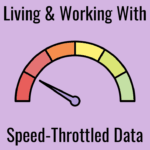 The mainstream press has been abuzz this week with news stories about fifth generation (5G) cellular "coming soon", thanks in large part to an AT&T announcement that it will begin testing 5G technologies in Austin later this year.
The mainstream press has been abuzz this week with news stories about fifth generation (5G) cellular "coming soon", thanks in large part to an AT&T announcement that it will begin testing 5G technologies in Austin later this year.
For some reason the AT&T story went viral and we have been getting a ton of questions about it, though Verizon's nearly identical disclosure in September last year about planning 5G trials in 2016 barely registered as a minor news blip.
So, just what is 5G?
Who is working on it?
When is it coming?
Table of Contents
5G Is Furiously Fast!

The goal of 5G networks will be to enable ridiculously fast peak cellular data rates of over 10 Gbps, with network latency as low as 1ms.
This represents a 50x increase in network throughput and capacity compared to the fastest currently deployed 4G/LTE networks.
5G will truly represent a major generational shift when these technologies are at last deployed, allowing cellular connections to potentially rival the performance of the fastest fiberoptic cable systems.
Every cellular technology provider and all of the carriers most certainly have 5G technologies on their mind or brewing in their labs, but only a few have spoken publicly about roadmaps or have revealed planned trials.
Verizon last September revealed that it intends to be the first to bring 5G to market in the USA, with lab trials happening in 2016 and a vague plan for "some level of commercial deployment" (likely a single test market deployment) to happen in 2017.
Not to be outdone - AT&T this week published its own 5G roadmap:
We plan to collaborate with Ericsson and Intel to work on 5G solutions in our labs starting in the second quarter of this year, with outdoor tests and trials over the summer. And, we expect field trials of 5G technologies to provide wireless connectivity to fixed locations in Austin before the end of this year. The trials will help guide our 5G standards contributions, and set the stage for widespread commercial and mobile availability once technology standards for 5G are established.
Not surprisingly - AT&T has been critical about Verizon's rush to be first to market with 5G, saying in December:
Some have been quick to claim plans to deploy 5G ahead of standards. However, those claims have been quite vague. They’re not clear about the actual “5G” technology and spectrum they’ll use. The requirements for 5G have not yet been defined, so it’s understandable. Even the most optimistic believe 5G standards completion is still years away. When it comes down to it, claims of a 5G deployment in 2016 are little more than marketing ploys.
After all - it is hard to deploy 5G to customers before there is an industry standard on what that technology actually is.
But AT&T seemingly isn't afraid of a little marketing ploy of its own, telling BGR.com yesterday that:
"An early use of 5G’s underlying technology could be delivering broadband to homes and businesses - it’s possible that we could have limited commercial availability this year depending on the trials.”
Perhaps we will soon end up with a repeat of the past - when AT&T and T-Mobile labeled their upgraded 3G networks as "4G" to hide that they were behind in bringing true 4G/LTE technology to market.
Though to be fair, those advanced 3.5G networks labeled as "4G" were actually just as fast as the first 4G/LTE networks...
So When Is “True” 5G Coming?

Despite the news this week - the truth is that 5G is not going to be a part of your RV's tech arsenal anytime soon.
Neither AT&T nor Verizon are currently planning any sort of consumer trial or any service that mobile customers will be able to sign up for.
What AT&T has done is received a provisional license from the FCC to conduct outdoor trials of experimental 5G technology in certain locations around Austin. Verizon last year secured a similar license to create 5G wireless test "sandboxes" near its labs in Massachusetts and San Francisco.
Other outdoor trials are gearing up to happen in Korea, China, Japan, and Europe too - and if various trials go well some test deployments to actual customers may happen within the next year or two.
A lot of other companies have been working under the radar as well - journalists from the The Guardian have dug up that Google's Project SkyBender is actually doing airborne 5G trials over Truth Or Consequences New Mexico!
More and more companies will be showing off potential 5G technologies and conducting public trials over the next few years as the core technologies and standards are hashed out, and 5G will be increasingly in the news.
But the actual 5G industry technical standards are not scheduled to be agreed upon and finalized until late 2019 - meaning that everything up until that point is just jockeying for leadership and leverage.
The earliest widespread commercial 5G deployments in the USA will most likely be no sooner than 2020.
LTE Has Plenty Of Evolution Left

Living up to its “Long Term Evolution” name, LTE networks were designed to continue to evolve with new capabilities and speeds while still remaining compatible with earlier LTE devices.
And there is still plenty of evolution left in the 4G/LTE pipeline before 5G comes along.
This ongoing evolution is known as LTE-Advanced (LTE-A), and eventually will be called LTE-Advanced Pro (which some companies are calling 4.5G) as the technology evolves.
The most significant emerging feature in LTE-A is known as Carrier Aggregation, which lets an LTE-A radio combine multiple LTE channels from different discontiguous chunks of spectrum to create a higher bandwidth virtual channel that can support faster speeds.
Some of the newer LTE devices (like the iPhone 6S) support two combined 20MHz channels for a peak theoretical cellular speed of 300Mbps, and some devices and networks are being upgraded to offer three aggregated channels for 450Mbps capabilities.
 And just this week Qualcomm, one of the world leaders in cellular modem chipsets, announced its new flagship Snapdragon X16 LTE Modem chipset, which may soon enable the first LTE-Advanced Pro devices to come to market.
And just this week Qualcomm, one of the world leaders in cellular modem chipsets, announced its new flagship Snapdragon X16 LTE Modem chipset, which may soon enable the first LTE-Advanced Pro devices to come to market.
The X16 is an amazing technological showcase - capable of using LTE-Advanced carrier aggregation technology to combine the spectrum of up to four different LTE frequency bands, while also using a 4x MIMO antenna to extract up to ten wireless data streams from the air at once - adding up to an amazing theoretical top speed of 1Gbps using todays underlying 4G/LTE technologies.
Though the X16 will be going into production later in 2016, it will still be several years before actual devices and deployed networks start to come even close to fully taking advantage of these sorts of theoretical capabilities.
But the LTE future is certainly looking bright!

An Amazing 5G Future?
It takes less than 5Mbps to stream HD video - so a lot of people are wondering just what use a 10Gbbps cellular connection capable of speeds 2,000x (!!!) faster than that might ever be good for.
Other than to enable blowing through an entire month's worth of capped data in a matter of seconds, that is!
But faster cellular networks aren't just a matter of speed - it is actually more a matter of capacity.
A 5G network with raw speeds 100x faster than 4G/LTE is capable of can handle 100x the number of users doing the same things that they do today, and because each individual radio has to spend less time broadcasting to get the same amount of data transferred - battery life on mobile devices can potentially substantially increase too.
In other words - the migration towards 5G will not just enable ultra-HD virtual reality streaming, advanced robotics, and self-driving cars - it will also drive the cost to send data dramatically downward, perhaps even to the point that carriers can afford to offer truly unlimited data plans again.
As AT&T mentioned in its 5G roadmap:
"Lowering the cost to deliver a megabyte of data is one of the reasons we were recently able to bring back an Unlimited Data offer."
Faster data is exciting - but for most RVers, nothing is more exciting than unlimited.
Book Update Progress Report
 We've been hard at work over the past several weeks writing the 2016 update of The Mobile Internet Handbook, including sections on better understanding LTE-Advanced and 5G technologies.
We've been hard at work over the past several weeks writing the 2016 update of The Mobile Internet Handbook, including sections on better understanding LTE-Advanced and 5G technologies.
Overall, this book update is proving to be a challenge. So much has changed in the past year, and RVMobileInternet.com has grown to become such a solid central resource center.
We’re diligently working on re-organizing the content of the book to make it even more accessible, more educational, and more helpful. A bunch of new content is being added too.
We're re-writing it to be more focused on theory with references to the ‘living guides’ we keep here at RVMobileInternet.com for the stuff that is more likely to change (products, plans, pricing).
We’re taking extra time to do it right. The Mobile Internet Handbook for 2016 may thus release a few days later than originally anticipated this year. It's going to be a complete refresh, and it's going to be awesome! We are hoping to have at least the eBook versions available in a week or so, and we'll then need to order proofs to approve the printed edition before it can go on sale, possibly in early March.
Our premium Mobile Internet Aficionado members will be the first to get their free eBook update the moment it is available.
Thanks for your patience! In the meantime...








 Mobile Internet Resource Center (dba Two Steps Beyond LLC) is founded by Chris & Cherie of
Mobile Internet Resource Center (dba Two Steps Beyond LLC) is founded by Chris & Cherie of